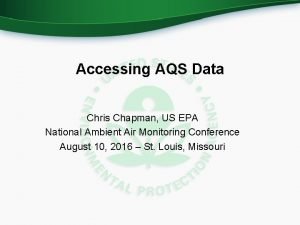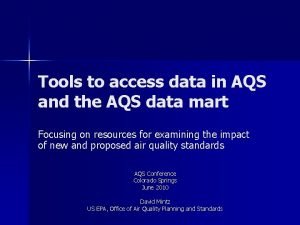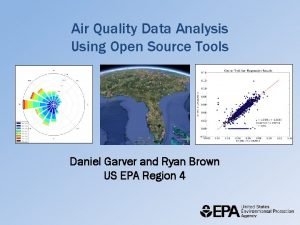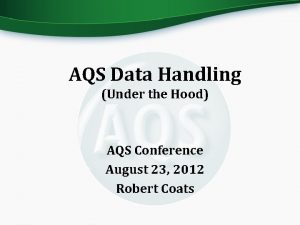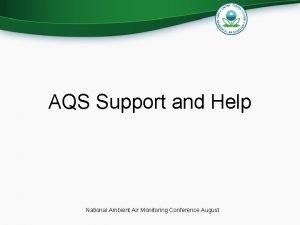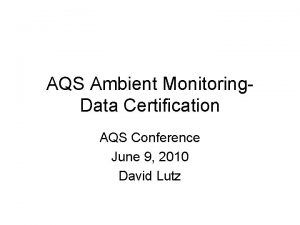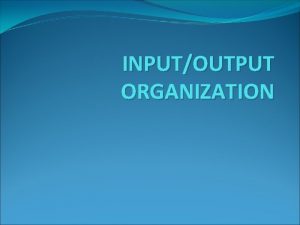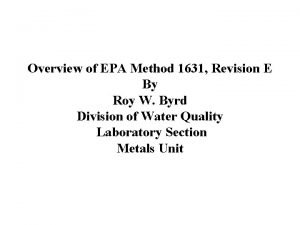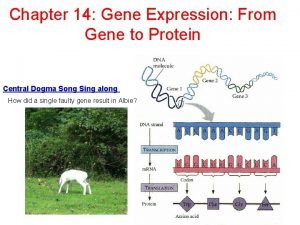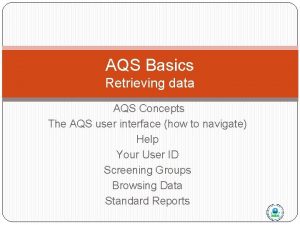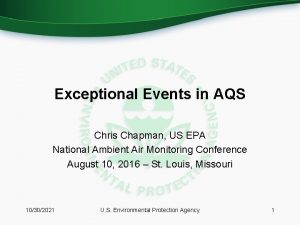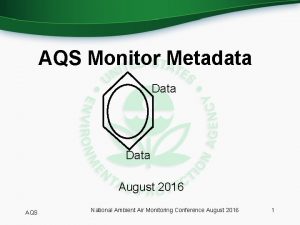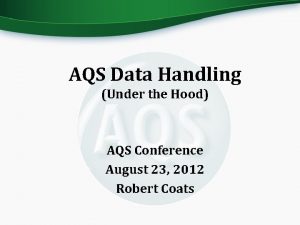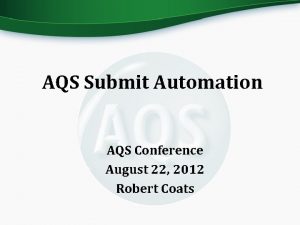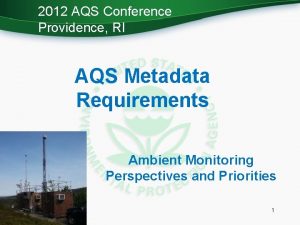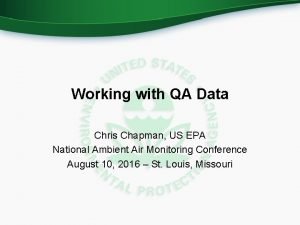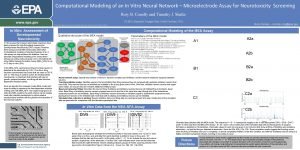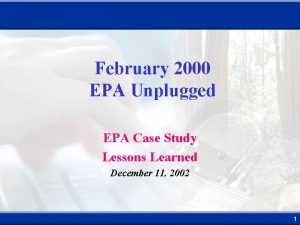Accessing AQS Data Chris Chapman US EPA National
























- Slides: 24

Accessing AQS Data Chris Chapman, US EPA National Ambient Air Monitoring Conference August 10, 2016 – St. Louis, Missouri

Outline • Background • Trends in Use – Popularity of data – Who’s getting the data – What are they getting • Data Sources – Air Data – AQS API – AQS Reports 12/4/2020 U. S. Environmental Protection Agency 2

Background • Several years ago, OAQPS embarked on an effort to reduce the number of places public could go to find data • Pick certain ones to enhance, others to decommission, put all that remain in a common place • The new umbrella site = Air. Data • AQS specific – Rebranding and rearchitecture of Air. Data (now AQS API) – Added addition AMP series reports, updated Existing reports (ex: Design Values report for 2015 Ozone NAAQS, added new QA reports (AMP 600, AMP 251, and AMP 256) 12/4/2020 U. S. Environmental Protection Agency 3

Sites • Air Quality data is in high demand • Air. Data: – https: //www 3. epa. gov/airquality/airdata/ – Reports, graphs, and downloads of criteria data – For analysts and informed public • AQS API: – https: //aqs. epa. gov/api – Web service for querying any raw data – For analysts and scientists • File Downloads: – http: //aqsdr 1. epa. gov/aqsweb/aqstmp/airdata/download_files. html – Bulk downloads of most requested raw data – For analysts and scientists 12/4/2020 U. S. Environmental Protection Agency 4

Trends in Use • • • Air Quality data is in high demand Air. Data: ~7, 000 queries per month AQS API: ~7, 000 queries per month File Downloads: ~45, 000 per month 25 billion rows of data queried since Jan 01, 2009 – 850 million since Jan 01, 2016 • 500 billion rows of data downloaded in files since Jan 01, 2016 • Every value input into AQS today will be viewed/used thousands of times over the next few years 12/4/2020 U. S. Environmental Protection Agency 5

User Categories • Heuristics based on contacts and email addresses – Academics – many(!) public health / epidemiologist users – NGOs • Mostly health related – Corporations • Regulated • App developers – Validation of small “sensors” (public/crowdsourced networks) • Business reasons: battery life, corrosion, etc. – SLTs (air quality and health departments) – Academics - model / satellite verification – Academics - Big Data / Data Science mining – Interested public 12/4/2020 U. S. Environmental Protection Agency 6

Types of Data (Anecdotal Trends) • PM 2. 5 & gaseous criteria pollutants continue to be very popular • Met data amazingly popular • PM 2. 5 speciation interest continuing to increase • Continuing interest in HAPs/VOCs 12/4/2020 U. S. Environmental Protection Agency 7

Data Sources • Air Data • AQS API • AQS - Reports 12/4/2020 U. S. Environmental Protection Agency 8

What is Air Data? • Publicly available tool…no registration required • Good for monitor network information, AQI (Air Quality Index) information and monitor, county and CBSA level summary information • Can download raw data via web service to AQS AQI • Access at https: //www. epa. gov/airdata/ • RSS Feed at https: //www. epa. gov/airdata/rssairdata. xml • Information at https: //www. epa. gov/airdata/ad_basic. html 12/4/2020 U. S. Environmental Protection Agency 9

Air Data Areas • Air. Data has many “areas” – Each targeted towards a different type of user • Reports – Tabular data (annual) that can also be downloaded – Criteria pollutants only, form of the standard • Visualizations (Plots) – Graphical data (daily data based) that can also be downloaded – Criteria pollutants only, form of the standard • Maps – Geographical data that can also be downloaded – Criteria, Speciation, and HAPS 12/4/2020 U. S. Environmental Protection Agency 10

Air Data Areas (Cont’d) Download § Daily (criteria pollutants only, form of the standard) § Raw (all pollutants) “AQS API” § Registration required (3, 200 registered users) § REST web services – use as GUI or API § Files § § § 12/4/2020 Pre-generated files of most commonly requested data Annual, daily, and hourly National, by year back to 1990 (~800 files) Updated twice a year, automated, only files that change CSV (not AQS) format Replaces TTN data download page U. S. Environmental Protection Agency 11

Air. Data Areas VISUALIZE DOWNLOAD REPORTS MAP RSS 12/4/2020 U. S. Environmental Protection Agency 12

What is the AQS Data Mart / AQS API? • Data Mart is a database containing all of the data from AQS – Powers Air. Data and AQS API, and has same architecture as AQS. – AQS Data Mart also includes ozone data for AQS monitors that are reported to Air. Now • Any “application” can connect to it (within tech/security limits) – Air. Data, KML files, Ozone Watch, Air. Compare, Data. gov • Intended users: – Air quality data analysts in the regulatory, academic, and health research communities – Those who need to download large volumes of detailed technical data – People who need the AQS data for the application they are building 12/4/2020 U. S. Environmental Protection Agency 13

AQS API INTERFACE (aqs. epa. gov/api) 12/4/2020 U. S. Environmental Protection Agency 14

AQS Reports (AMP xxx) – Briefly mentioned earlier – Trend also continues upward • 71, 000 in CY 2015, 39, 000 is 1 H CY 2016. This averages to more than one every 2 minutes during business hours – Does not include Load Summary/Error reports – Does include automatically generated SG inventory report – We’d like to retire some, but all are used – We’ve added more, hopefully helpful – We’re working on streamlining 12/4/2020 U. S. Environmental Protection Agency 15

AQS Reports Interface (R 31) 12/4/2020 U. S. Environmental Protection Agency 16

Reports by Category Reports Site and Monitor Metadata AMP 380 (Site Description), AMP 390 (Monitor Description), AMP 220 (Monitor Networks) Detail Data Reports AMP 500(Extract Site/Monitor Data), AMP 501 (Extract Raw Data), AMP 503 (Extract Blanks Data), AMP 350 MX, AMP 350 P, and AMP 350 NW (Raw Data) Summary Data Reports AMP 500(Extract Site/Monitor Data), AMP 501 (Extract Raw Data), AMP 503 (Extract Blanks Data), AMP 350 MX, AMP 350 P, and AMP 350 NW (Raw Data) Certification and QA AMP 600 (Certification Evaluation and Concurrence), AMP 256 (QA Data Quality Indicator), AMP 251 (QA Raw Assessment) AMP 504 (QA Data Extraction) Others AMP 480 (Design Value), AMP 360 (Raw Data Qualifiers), Reports not run from R 31 interface (AMP 395, AMP 396, Load, Scan, Post). 12/4/2020 U. S. Environmental Protection Agency 17

AQS Reports Documentation • User’s Guide: https: //www. epa. gov/aqsusers-guide-0 • Data Retrieval Guide currently being updated. When complete will have full explanation of all reports 12/4/2020 U. S. Environmental Protection Agency 18

Intended audience AQS API AQS • Air quality data • Those who provide • Designed for analysts in the regulatory, academic, and health research communities • People familiar with the data • An AQS account is not needed data from their federal, state, local, or tribal agency to the EPA • Standard reports are available for QA 12/4/2020 U. S. Environmental Protection Agency Air Data public access (no registration required) • Also useful for researchers and analysts who can download raw data 19

Registration AQS API AQS Air Data • Requires password • Registration at AQS • Not required • Self-registration at site: https: //www. epa. gov/aq s/aqs-user-registration Must go through S/L/T/Regional approval process • Must be Fed or State/Local/Tribal employee or designated contractor home page • Anyone can register 12/4/2020 U. S. Environmental Protection Agency 20

Examples of output AQS API AQS Reports Air Data • CSV • Acrobat (pdf) • On screen • Pipe delimited • Workfile (txt) • Downloadable as csv • JSON • Visualizations (jpg, gif) 12/4/2020 U. S. Environmental Protection Agency 21

Update frequency AQS API AQS Air Data • Weekly • Continuously • Same schedule as • Sunday night Updated by State / Local / Tribal Organizations • Summaries Re. Computed when Posted AQS API • Updated by Automated Process 12/4/2020 U. S. Environmental Protection Agency 22

A moment of silence for Discoverer • An Oracle tool that is no longer supported by Oracle although it is still available to AQS users • May be decommissioned by NCC at any time • Replacement still under consideration / prioritization 12/4/2020 U. S. Environmental Protection Agency 23

Conclusion • Demand for data increasing • Keep up the good work – more and more people using and depending on the data • We’re continually adapting to new requirements and new constraints (technology, budget, time, etc. ) • Suggestions welcome 12/4/2020 U. S. Environmental Protection Agency 24
 Aqs data
Aqs data Aqs data mart
Aqs data mart Aqs data mart
Aqs data mart Accessing mainframe data from java
Accessing mainframe data from java Aqs chevrolet
Aqs chevrolet Aqs status
Aqs status Aqs in urdu
Aqs in urdu Aqs training
Aqs training Aqs training
Aqs training Aqs certification
Aqs certification Accessing i/o devices
Accessing i/o devices Accessing io devices
Accessing io devices Flipping bits in memory without accessing them
Flipping bits in memory without accessing them Allows the replication of only immutable files
Allows the replication of only immutable files Downloading and accesing
Downloading and accesing Accessing input output devices
Accessing input output devices Nycaapse
Nycaapse City and guilds epa price list
City and guilds epa price list Epa method 1631e
Epa method 1631e Icaew project report
Icaew project report Ribosome epa site
Ribosome epa site Epa sport niedersachsen
Epa sport niedersachsen One gene one enzyme hypothesis
One gene one enzyme hypothesis Bases curriculares epa
Bases curriculares epa Epa swmm descargar
Epa swmm descargar
